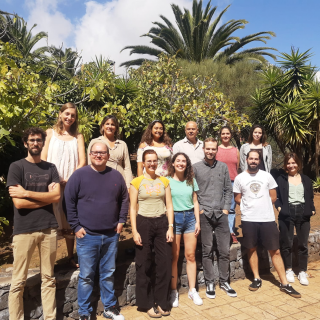Bibcode
Bittner, Adrian; Sánchez-Blázquez, Patricia; Gadotti, Dimitri A.; Neumann, Justus; Fragkoudi, Francesca; Coelho, Paula; de Lorenzo-Cáceres, Adriana; Falcón-Barroso, Jesús; Kim, Taehyun; Leaman, Ryan; Martín-Navarro, Ignacio; Méndez-Abreu, Jairo; Pérez, Isabel; Querejeta, Miguel; Seidel, Marja K.; van de Ven, Glenn
Bibliographical reference
Astronomy and Astrophysics
Advertised on:
11
2020
Journal
Citations
60
Refereed citations
54
Description
The centres of disc galaxies host a variety of structures built via both internal and external processes. In this study, we constrain the formation and evolution of these central structures, in particular, nuclear rings and nuclear discs, by deriving maps of mean stellar ages, metallicities, and [α/Fe] abundances. We use observations obtained with the MUSE integral-field spectrograph for the TIMER sample of 21 massive barred galaxies. Our results indicate that nuclear discs and nuclear rings are part of the same physical component, with nuclear rings constituting the outer edge of nuclear discs. All nuclear discs in the sample are clearly distinguished based on their stellar population properties. As expected in the picture of bar-driven secular evolution, nuclear discs are younger, more metal-rich, and exhibit lower [α/Fe] enhancements, as compared to their immediate surroundings. Moreover, nuclear discs exhibit well-defined radial gradients, with ages and metallicities decreasing, and [α/Fe] abundances increasing with radius out to the nuclear ring. Often, these gradients show no breaks from the edge of the nuclear disc up through the centre, suggesting that these structures extend to the very centres of galaxies. We argue that continuous (stellar) nuclear discs may form from a series of bar-built (initially gas-rich) nuclear rings that expand in their radius as the bar evolves. In this picture, nuclear rings are simply the (often) star-forming outer edge of nuclear discs. Finally, by combining our results with those taken from a accompanying kinematic study, we do not find evidence for the presence of large, dispersion-dominated components in the centres of these galaxies. This could be a result of quiet merger histories, despite the large galaxy masses, or, perhaps, due to high angular momentum and strong feedback processes preventing the formation of these kinematically hot components.
Related projects

Galaxy Evolution in Clusters of Galaxies
Galaxies in the universe can be located in different environments, some of them are isolated or in low density regions and they are usually called field galaxies. The others can be located in galaxy associations, going from loose groups to clusters or even superclusters of galaxies. One of the foremost challenges of the modern Astrophysics is to
Jairo
Méndez Abreu

Traces of Galaxy Formation: Stellar populations, Dynamics and Morphology
We are a large, diverse, and very active research group aiming to provide a comprehensive picture for the formation of galaxies in the Universe. Rooted in detailed stellar population analysis, we are constantly exploring and developing new tools and ideas to understand how galaxies came to be what we now observe.
Ignacio
Martín Navarro